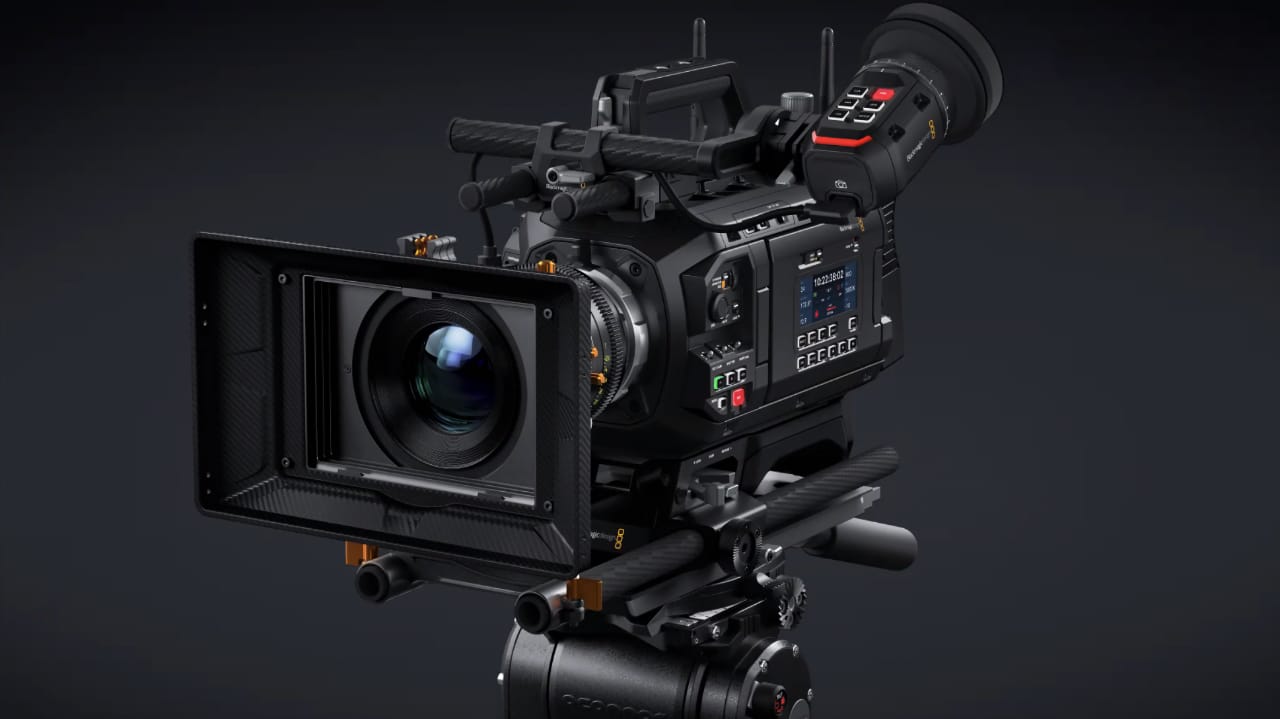
Built around a new 12K 35mm Large Format sensor and with 16 stops of range and 8TB onboard memory, the Blackmagic URSA Cine 12K has been designed from the ground up for high-end digital cinema.
More to come from Blackmagic at NAB, but let's start here. The new Blackmagic URSA Cine 12K is the result of the company wholly deconstructing its camera range and putting together a completely new device aimed at high end digital cinema with no barriers on features or cost. The fact that it has done that and still come up with something under $15k says an awful lot about its design philosophy.
One of the key principles that has guided this process is acknowledging that a digital cine camera is no longer a standalone component but rather part of an ecosystem; it’s involved in digital film chains that connect to the video village and outside of the studio space or location with cloud-based workflows. As such the Blackmagic URSA Cine 12K comes with a huge range of inputs and outputs, including 10 Gigabit Ethernet, that pretty much allows people downstream to start working with the image data as soon as it's captured.
Another of the design rules its followed that is going to be popular with users is tool-less adaptability. As much as possible — and there is a lot of possible, this is a very adaptable camera — all configuration changes can be made with locking nuts. You can take the new EVF off and adjust its positioning, remove it from its support system to go handheld, and pretty much handle every job around the camera without taking your gloves off on a chilly day.
New 12K 35mm large format sensor
Let’s start though with what the URSA Cine 12K is built around, the new 12K 35mm large format sensor. This is not an evolution of the company’s current 12K sensors, but something completely new. Blackmagic says it designs and manufactures it (or at least oversees that last part somewhere else - though we are happy to stand corrected on that front). But either way that gives it a granular control over all aspects of it and allows it to accentuate capabilities in other areas of the workflow, such as downstream with Resolve.
Indeed, it says that Resolve color science is built into the sensor itself.
It’s also got bigger photo sites than before, which the company says provides the camera with 16 stops of dynamic range.
Here’s the spec followed by the pdf of all the formats it supports. As you can see from the table, at full resolution you’re going to get about 80fps out of it.
Horizontal Size: 35.6352mm
Vertical Size: 23.316mm
Diameter: 42.59mm
Horizontal Resolution: 12,288 pixels
Vertical Resolution: 8,040 pixels
Click to expand...
The full sensor area gives customers a 3:2 open gate image which lets customers reframe their shots in post production. Or customers can use the large sensor area to shoot anamorphic and deliver in a range of aspect ratios with 1.3, 1.5, 1.6, 1.66, 1.8 and 2x de-squeeze factors. Plus, customers can shoot in 4K, 8K or 12K using the entire sensor without cropping, retaining the full field of view of their lenses. One interesting quirk you’ll note is the introduction of 9K resolution and 9K Super 35 4-perf, 3-perf and 2-perf modes for full compatibility with classic cinema lenses.
Innovation all round
The current Blackmagic EVF is good, but the mounting system can be seen a little bit restrictive. The result of the redesign process is an EVF with a highly modular adaption. It can move fore and aft, up and down, and can be adjusted to whatever shooting configuration you want, even more so with an extension arm accessory.
It features a high quality 1920 x 1080 color OLED display with built in proximity sensor, 4 element glass diopter for incredible accuracy with a wide focus adjustment. A built in digital focus chart ensures customers get perfect viewfinder focus setup.
At the top of the EVF are three user definable buttons alongside the three usual Zoom, Exp, and Rec for things such as false colour, zebras. It basically allows you to control the camera from the EVF directly, which is neat.
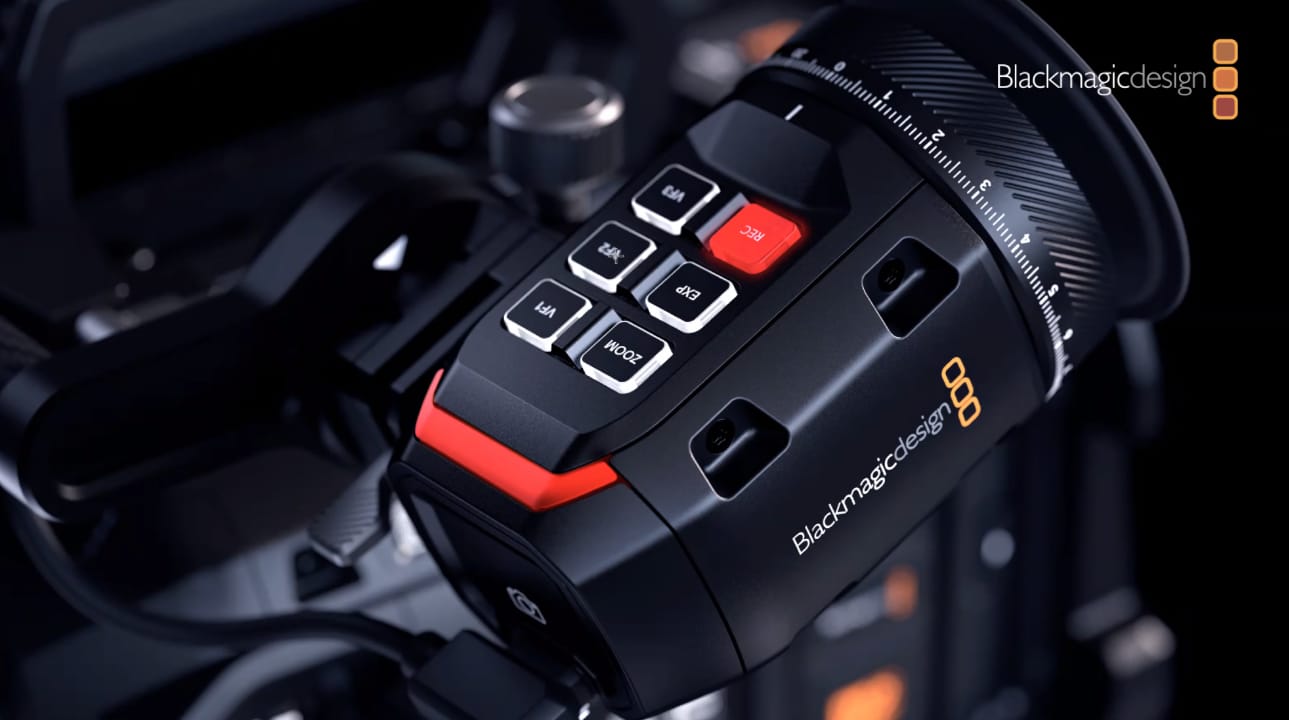
The camera ships with a 19mm rod set up, though a 15mm base plate is also available. What’s impressive is the degree of innovation all round its body that has come from the whole taking it apart and putting it back together again process, as well as taking into consideration user feedback.
Some of this is really detailed. All the buttons are backlit and, whereas mechanical buttons on previous Blackmagic cameras used to make an audible click, these are now all soft touch to assuage concerns of people shooting on sound stages in really, really quiet environments.
On the left-hand side off the camera is a status LCD that gives you all the information regarding shooting format or codec etcetera at a glance. Audio controls are also here alongside some user-definable buttons. The LCD can open up to provide a 5-inch touchscreen, running the standard Blackmagic camera OS, though a few extra pages and options have been added. The monitor rotates all the way round too, so you can shoot from the front of the camera. It also folds back flush into the camera with the monitor open, allowing for operation even if you have to put cheeseplates or other kinds of rigging around it.
This has all been done to give as much adaptability to different shooting styles and how people want to rig their cameras as possible.
There's another screen on the right hand side of the camera as well which can be used by focus pullers and other crewmembers that allows them to have access to camera management and information. This even includes a sunshade, so that the screen can be seen clearly in all conditions, as well as a newly designed UI for focus positions. This software can take various metadata in from the usual smart lens technologies, and the hope is it might even be expanded to include info from motors, drives and more.
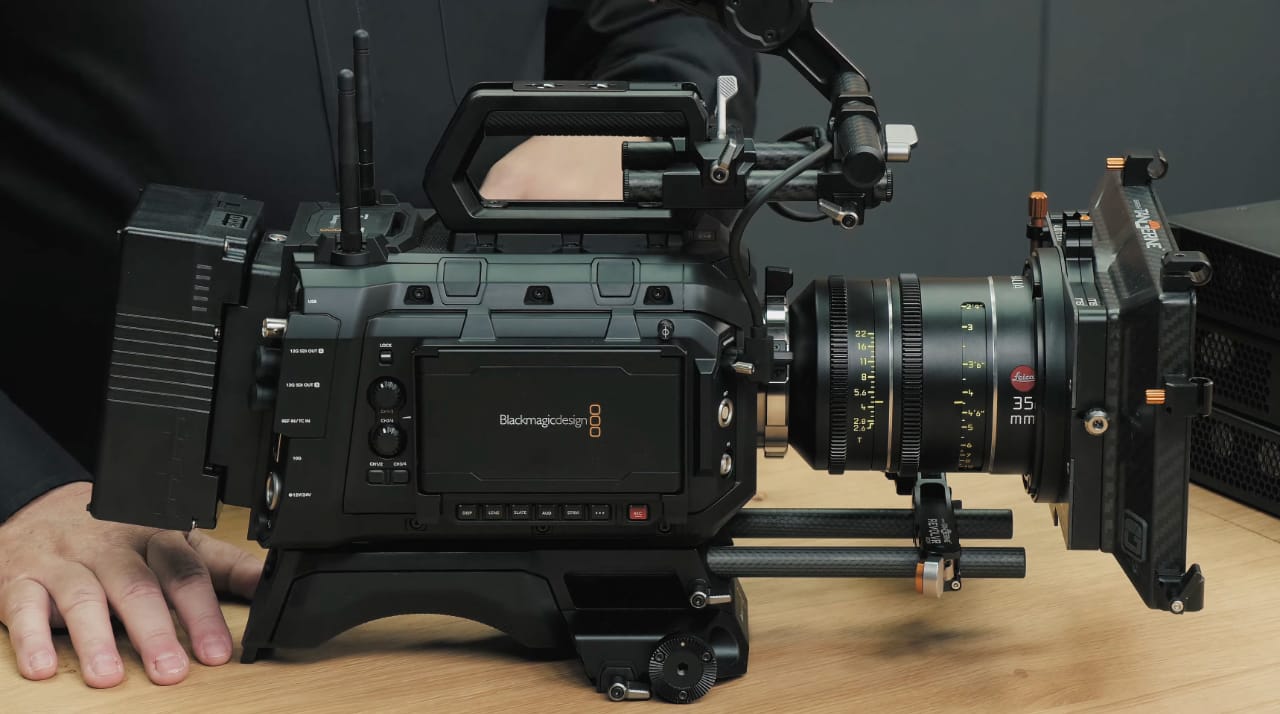
As for power, the camera comes with a massive 250W power supply and B Mount battery plate. The reason this was chosen is because there is a higher availability of 24V batteries, and given the potential amount of accessories being driven by multiple ports around the camera, a 12V solution was never really going to cut the mustard. Other options will be available for battery mounting, with Blackmagic, saying Anton Bauer, Gold Mount, and V-Mount, will be available at some point.
Around the front of the camera, you'll see two external ports, a seven-pin Lemo that will provide communication with different third-party motors for focus, aperture, and more. There's a two-pin Lemo connector as well, allowing uses to power other external accessories.
The PL lens mount comes preinstalled on the camera body, plus customers get an interchangeable locking EF mount for a strong and secure attachment when using heavier cine lenses.
And last, but not least, one of its standout features are the two antennas sticking out of the top that provide built-in WiFi. This is designed for two main purposes; pulling proxies off wirelessly, if the camera is set up in such a way that an Ethernet link is impractical; or streaming using the SRT transport built into the camera via a local WiFi connection. Effectively, you can stream directly onto socials, to directors, to VFX, to another essential crewmembers, and a whole lot more.
These considerations help make that $15,000 price all the more competitive when you realise you don't have to be slapping on another externally mounted system. That's not to say that there won't be accessories, there will, and Blackmagic says it is going to produce a range that will extend beyond the currently available Cine Grips or EVF extender.
Onboard storage
Another area where the URSA Cine 12K has outdone itself is in onboard storage. Have a good look at one of the side views and you will see two M.2 modules.
At high frame rates and large formats the company says it is difficult to get all the data out of a camera reliably and efficiently, even when throwing the kitchen sink at it. So the company created a whole new module to improve onboard storage. In fact it will ship with a mammoth 8TB module that holds four M.2 NVMe memory cards fed in turn by a total of 16 PCIe express lanes. This not only provides a hell of a lot of throughput now, but also should provide a decent amount of future expansion capacity too.
It allows customers to capture over 4 hours of Blackmagic RAW in 12K or a massive 20 hours in 4K.
A lot can happen without data ever leaving the camera as a result. Using that 10 Gigabit Ethernet port, a DIT, for example, can connect directly into the camera and manage media as it’s captured. Editing, media management, color grading…that can all be done in the camera.
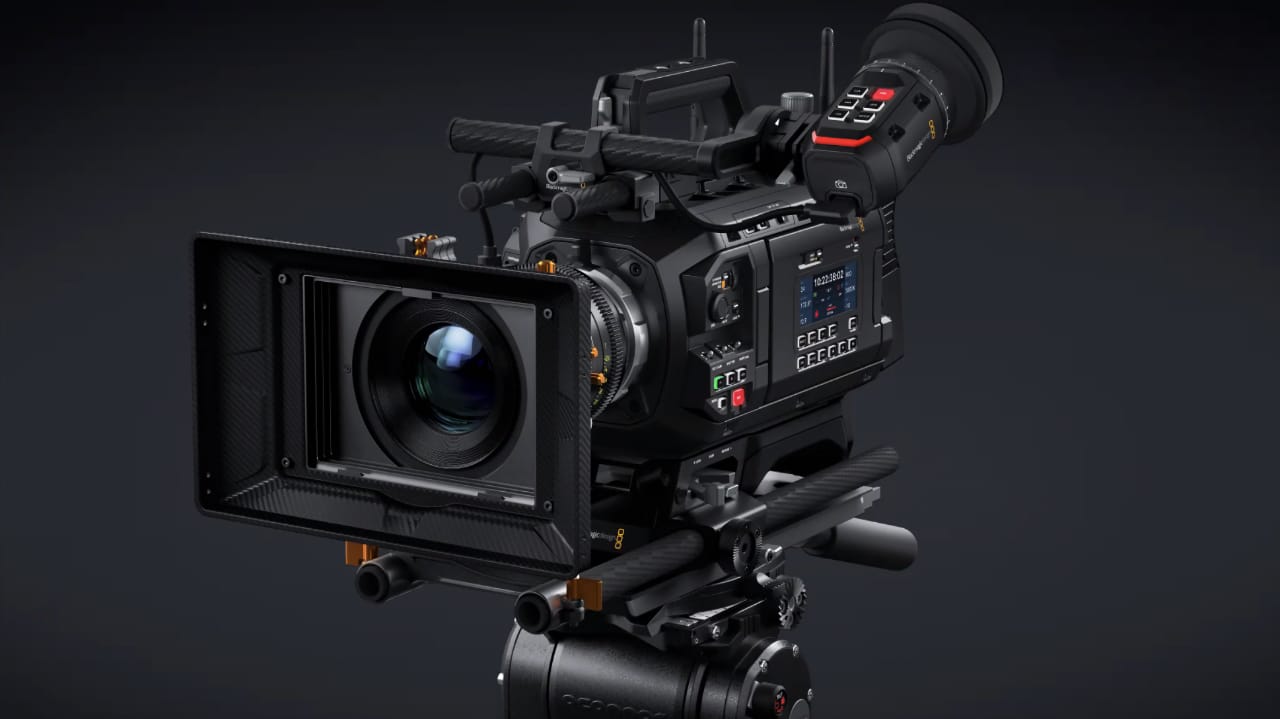
There will also be an external dock the module can plug into that can effectively become a cloud store. That makes it more than a NAS and a full on collaborative workspace. It becomes a hub effectively, one from which users can send out proxies or OCFs, or both, and replicate those out to other cloud stores to allow editing houses, post houses, and more to work simultaneously on the same media.
Blackmagic also promises a CFexpress module for those that don’t want to go the M.2 route.
Pricing and availability
All in all, it's an impressive unit at an equally impressive price. That $15,000 headline price though does not include the EVF, which is going to add another $1600 on to the overall figure. All the same, in terms of bang for your buck, it’s a lot.
There's even a decent unboxing experience to come with it too. Every camera comes in a rugged Pelican case with custom foam cutouts that precisely and securely fit the camera and its accessories.
So, when will you be able to buy it? The cameras are being manufactured right now and there will be some to look at and play with on the NAB show floor. Blackmagic says it will have a limited supply available to a select number of users. It's not actually calling these beta testers, but the impression is that any and all feedback will be considered and appreciated. This is especially important when it comes to the real world testing of the focus pullers menu and some of the third-party integrations that productions will inevitably want to run with.
Mass production is planned for some point over the summer, with an optimistic schedule looking at June. And as soon as we get our hands on one, we’ll be sure to tell you all about it.
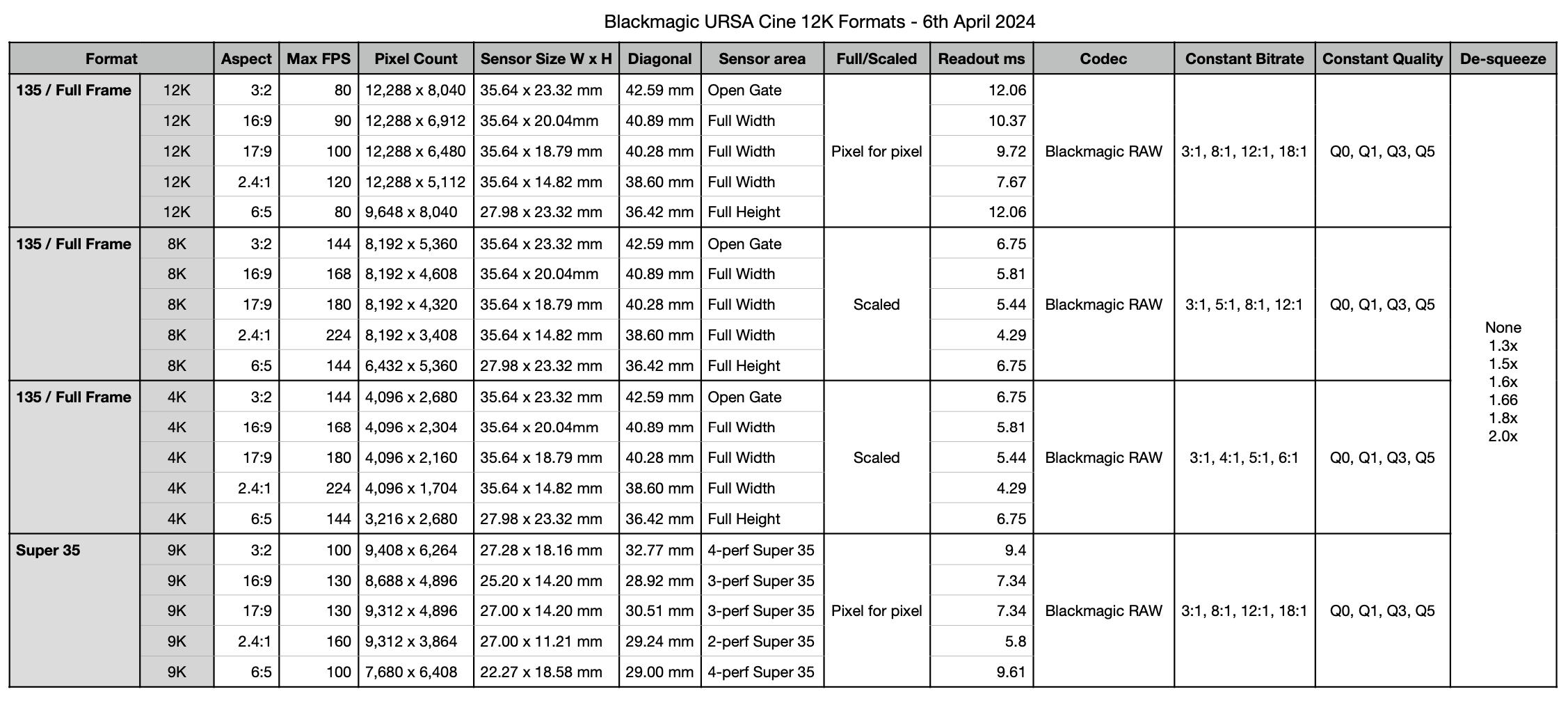


Comments